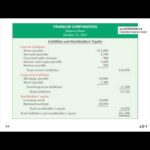
The passive activity limitations don’t apply to the partnership. Instead, they apply to each partner’s share of any income or loss and credit attributable to a passive activity. Because the treatment of each partner’s share of partnership income or loss and credit depends on the nature of the activity that generated it, the partnership must report income or loss and credits separately for each activity. Payments made by transferee partnerships to eligible taxpayers for the purchase of eligible credits as a result of a transfer election under section 6418 are treated as nondeductible expenses and are reported on this line 18c. Don’t include separately stated deductions shown elsewhere on Schedules K and K-1, capital expenditures, or items the deduction for which is deferred to a later tax year.
What Is the Penalty for Failing to File Form 1065?
A partnership currently can obtain an automatic six-month filing extension to Sept. 15. Partnerships that fail to file their returns on time are subject to a penalty of $220 per partner for each month they delay. Schedule K’s analysis of net income (loss) is a breakdown of the income or loss according to the nature of the partnership (corporate, individual (active), individual (passive), etc.). It further segregates the income and loss among general partners and limited partners.

Review and File with the IRS
- Refigure the depletion deduction under section 611 for mines, wells (other than oil and gas wells), and other natural deposits for the AMT.
- See section 471(c)(1), and Change in accounting method, later.
- We believe everyone should be able to make financial decisions with confidence.
- See section 263A(i), and Change in accounting method and Limitations on Deductions, later.
- Enter each partner’s distributive share of interest income in box 5 of Schedule K-1.
When it comes to declaring such shelters with the IRS while submitting Form 1065, there are specific rules that partnerships need to adhere to. The second update pertains to family and sick leave payroll credits under the Families First Coronavirus Response Act (FFCRA). These provisions allow employers – including multi-member LLCs treated as partnerships – to claim credit for certain paid leaves provided through September 30, 2023 due to COVID-related reasons.

Is partnership income considered self-employed income?
Don’t reduce the amount of the allowable deduction for any portion of the credit that was passed through to the partnership from another pass-through entity. See the instructions for the credit form for more information. Interest expense paid or incurred during the production period of designated property must be capitalized and is governed by special rules. For more details, see Regulations sections 1.263A-8 through 1.263A-15.
Business Codes
Check the “Amended K-1” or “Amended K-3” box at the top of the Schedule K-1 or K-3 to indicate that it’s an amended Schedule K-1 or K-3. If you and your spouse make the election for your rental real estate business, you each must report your share of income and deductions on Schedule E (Form 1040), Supplemental Income and Loss. Rental real estate income isn’t generally included in net earnings from self-employment subject to self-employment tax and is generally subject to the passive loss limitation rules. Electing QJV status doesn’t alter the application of the self-employment tax or the passive loss limitation rules. Because partnerships and LLCs are pass-through entities, profits and losses pass through directly to the partners or LLC members, who report and pay taxes on their share of the business income on their personal tax returns. So, although a partnership or LLC must file a single IRS Form 1065, the business itself does not pay the income tax.
Square Capital Review: Two Square Merchants Share Their Personal Experience
SSTBs and PTPs can’t be aggregated with any other trade or business. So, if the aggregation box is checked, the SSTB and PTP boxes for that specific aggregated trade or business shouldn’t be checked. The following examples assume that the described partnership liabilities are properly allocable to the partner in the examples under the rules of section 752. Report nonqualified withdrawals by the partnership from a CCF to partners. Dispositions of property with section 179 deductions (code L).
Enter on line 15c the total qualified rehabilitation expenditures related to rental real estate activities of the partnership. See the Instructions for Form 3468 for details on qualified rehabilitation expenditures. On an attached statement, identify https://www.kelleysbookkeeping.com/what-are-the-effects-of-overstating-inventory/ the property for which the expenditures were paid or incurred. If the expenditures were for intangible drilling costs or development costs for oil and gas properties, identify the month(s) in which the expenditures were paid or incurred.
Instead, the partnership must pass through to each partner in box 13, code J, of Schedule K-1 the information needed to figure the deduction. If the partnership is a qualified farmer or rancher (as defined in section 170(b)(1)(E)(v)), show each partner’s distributive share of qualified conservation contributions of property used in agriculture or livestock production. Partners will have to separately determine whether they qualify for the 50% or 100% AGI limitation for these contributions. Don’t include the amounts reported on the attached statement using code G in the amount reported on Schedule K-1 for qualified conservation contributions using code C. Generally, a taxpayer with a trade or business must file Form 8990 to claim a deduction for business interest.
Generally, a limited partner’s share of partnership income (loss) isn’t included in net earnings (loss) from self-employment. Limited partners treat as self-employment earnings only guaranteed payments for services they actually rendered to, or on behalf of, the partnership to the extent that those payments are payment for those services. Enter the partner’s distributive share of the allowable reforestation expenses in box 13 of Schedule K-1 using code S and attach a statement that provides a description of the qualified timber property. If the partnership is electing to deduct amounts from more than one qualified timber property, provide a description and the amount for each property. Enter the payments for a partner to an IRA, a qualified plan, or a SEP or SIMPLE IRA plan. If a qualified plan is a defined benefit plan, a partner’s distributive share of payments is determined in the same manner as the partner’s distributive share of partnership taxable income.
So if you’re a vlogger who somehow accidentally uses a NAICS code implying you’re a delivery driver, some of your legitimate write-offs might look like red flags. The six digits in a NAICS code are part of a series of progressively narrower categories. Use the first two to find the broad category your business belongs to, such as Agriculture, Forestry, Fishing, and Hunting (11) or Accommodation, Food Services, & Drinking Places (72). Schedules L and M-1 contain items that will have to match items on M-2, so make sure to fill those out first before filling out M-2.
Include on line 2a the amount of money contributed by each partner to the partnership, as reflected on the partnership’s books and records. Include on line 2b the adjusted tax basis of property net of liabilities contributed by each partner to the partnership, as reflected on the partnership’s books and records. Partnerships must separately report QBI information for all trades or businesses engaged in by the partnership, including SSTBs, but must identify which trades or businesses are SSTBs. This amount represents recapture of the section 179 deduction if business use of the property dropped to 50% or less before the end of the recapture period.
Section 704(c) property is property that had an FMV that was either greater or less than the contributing partner’s adjusted basis at the time the property was contributed to the partnership. See Dispositions of Contributed why you should get a cpa to prepare your taxes Property , earlier, for more information. If the partnership made such a distribution during its tax year, attach a statement to the contributing partner’s Schedule K-1 that provides the following information.
Remember, every dollar saved on penalty fines counts towards bottom-line profitability. So make sure to seek expert advice before proceeding to file. To navigate through these changes effectively without https://www.quickbooks-payroll.org/ making errors that could lead to penalties or audits by the IRS, consider seeking assistance from professionals who specialize in business taxation issues, like those here at Silver Tax Group.
The OPI Service is a federally funded program and is available at Taxpayer Assistance Centers (TACs), other IRS offices, and every VITA/TCE return site. The last section of Form 1065, Schedule M-2, shows the changes in the partners’ capital accounts. The answers to these questions are going to be specific to your business, and therefore, it will be helpful to have all your financial information organized and available and to consult a certified public accountant or other tax professional. Due to the amount of forms, information and financial data involved in this process, it’s a good idea to use accounting or tax software, as well as to work with a business accountant or tax advisor.
The IRS now requires more detailed reporting if this question is answered affirmatively – ensuring transparency and accuracy when it comes to ownership stakes within partnerships. In recent years, there have been several adjustments made to Schedule B of Form 1065 – a section where partnerships provide additional operational details that don’t fit elsewhere on the form. Information from Schedule K of Form 1065 is separated by type of income, deduction, credits, or other information. The lines on Schedule K-1 for each partner echo those on Schedule K. Partnerships use Schedule B-1 (Form 1065) to provide information applicable to certain entities, individuals, and estates that own, directly or indirectly, an interest of 50% or more in the profit, loss, or capital of the partnership. Schedule M-1 will allow you to explain any differences you may have between your bookkeeping income and tax return income.